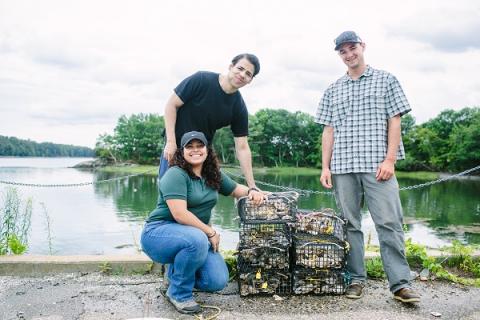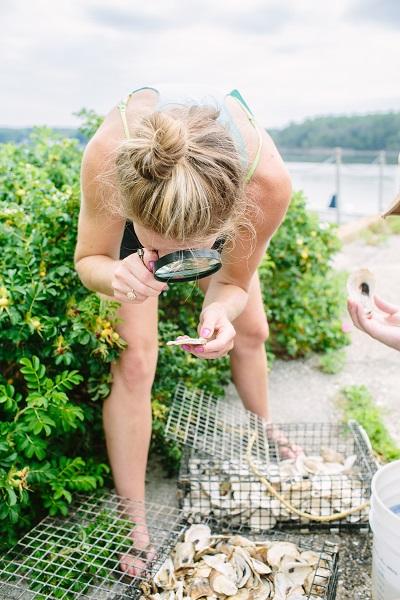
What is Oyster Restoration?
Oysters are a favorite seafood for some, but in the marine ecosystem they serve an even more important role. When oysters feed, they filter excess nutrients and particles from the water column, essentially “cleaning” the water of a bay or estuary. A combination of threats, including pollution, overharvesting, and disease, has caused a severe decline in oyster populations in New Hampshire’s Great Bay Estuary since the 1970s. To increase the “filtering” of the Great Bay system, federal and state efforts have focused on restoring oyster populations.
Coastal Research Volunteers participate in many steps of this restoration process: we prepare shells for the construction of a new two-acre reef, we monitor juvenile oysters to help them reach a size where they can more easily survive, and we work with The Nature Conservancy’s Oyster Conservationist Program to enable shoreline homeowners to raise young oysters (spats) to be used for restoration.
What do oyster restoration volunteers do?
There are many ways to help with oyster restoration! If you have access to waterfront property, you can participate in the Oyster Conservationist Program, which entails raising a cage of oysters for 10 weeks (mid-July through September), checking on the oysters once per week, and collecting a small amount of data on oyster size every other week.
If you don’t have a place to raise oysters, there are many other ways to volunteer, from preparing oyster shells for new baby oysters to measuring and counting young oyster spat.
Oyster Conservationists will spend 10 weeks raising oysters, requiring once-a-week check-ins and a quick data collection every other week. Other oyster volunteer opportunities are one-time commitments, typically lasting a few hours.
Oysters raised through volunteer oyster restoration efforts go directly into the Great Bay, restoring its natural filtration capacity and improving its water quality. Since 2009, this collaboration between The Nature Conservancy and UNH has restored more than twenty-five acres of reef and 3.5 million oysters to the Piscataqua Region Estuary!
You can read the annual reports from the past several years using the links below:
- Interest in handling oysters and improving the water quality of the Great Bay
- To be an Oyster Conservationist, you must have access to shoreline property where you can raise oysters
- Meet people from your community with similar interests
- Opportunity to handle and learn about oysters
- Contribute to a long-term dataset used to improve the water quality of the Great Bay
Questions? To join the 2018 Oyster Conservationist Program in raising young oysters or to volunteer for upcoming spat counts or other oyster restoration activities, contact Brianna Group (TNC).
Join our oyster restoration effort!
The 2018 oyster restoration season finished in October when volunteers readied this year's oyster cohort for placement in Great Bay. Visit The Nature Conservancy website and sign up for the CRV monthly newsletter to find out about oyster restoration volunteer opportunities in 2019.
Links, resources, and partner organizations
Read all about The Nature Conservancy’s oyster restoration work, check out this timeline of oyster restoration volunteer needs, read this Portsmouth Herald article, Restoration efforts of Great Bay making 'measurable progress' , and enjoy this video about The Nature Conservancy's Oyster Conservationist volunteers.
An effort this big can’t be taken on alone, so make sure you also check out the websites of all of our partners in oyster restoration:
- NH Fish and Game
- Natural Resources Conservation Service
- National Oceanic and Atmospheric Administration
- Piscataqua Region Estuaries Partnership
- NH Moose Plate Program
- Davis Foundation
